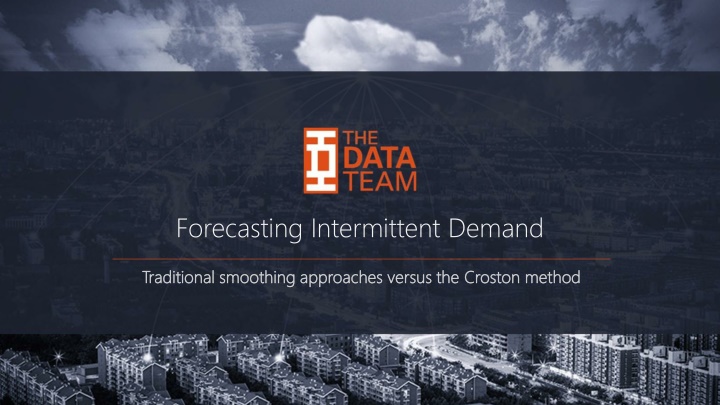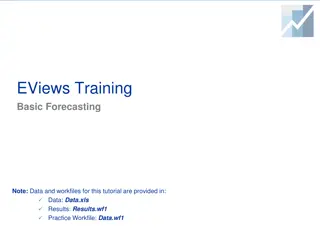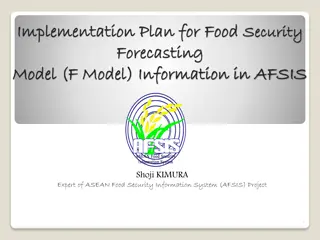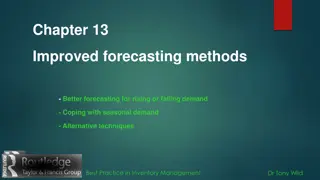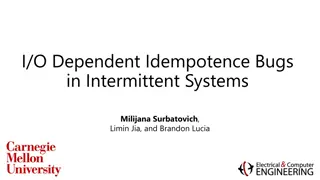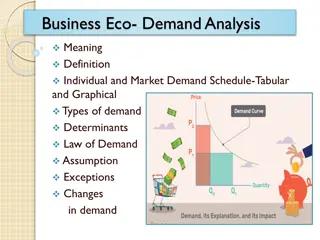Forecasting Intermittent Demand Using Croston Method
Intermittent demand poses challenges for traditional forecasting methods. This article explores the difficulties with exponential smoothing, ARIMA, and simple moving average techniques, and highlights the importance of applying the Croston method for accurate predictions. Various methods for forecasting intermittent demand, including model-based and ad-hoc approaches, are discussed. Comparative analysis on real-world SKUs data in R demonstrates the impact of enhanced forecasting on business outcomes.
Download Presentation

Please find below an Image/Link to download the presentation.
The content on the website is provided AS IS for your information and personal use only. It may not be sold, licensed, or shared on other websites without obtaining consent from the author.If you encounter any issues during the download, it is possible that the publisher has removed the file from their server.
You are allowed to download the files provided on this website for personal or commercial use, subject to the condition that they are used lawfully. All files are the property of their respective owners.
The content on the website is provided AS IS for your information and personal use only. It may not be sold, licensed, or shared on other websites without obtaining consent from the author.
E N D
Presentation Transcript
Forecasting Intermittent Demand Traditional smoothing approaches versus the Traditional smoothing approaches versus the Croston Croston method method
About Me Masters in Business Analytics from National University of Singapore. 5+ Years experience in Tech Consulting and Insurance Industry. Have worked on projects for Manufacturing, Insurance and Retail Clients. Helping enterprise transformation through RoboticDataScience*. Prateek Nagaria Prateek Nagaria Data Scientist Data Scientist The Data Team, Singapore. The Data Team, Singapore. Email: prateek.nagaria@thedatateam.net *Visit at Data Team s Booth (No. 6) to know more about Robotic Data Science. *Visit at Data Team s Booth (No. 6) to know more about Robotic Data Science.
What will we learn today What is Intermittent demand? Why is it difficult to forecast intermittent demand using Traditional Methods? Methods for Intermittent demand forecasting. How to apply and interpret Croston method. Comparative analysis on Real-World SKUs data in R. What is the Impact of better forecast on your business?
What is Intermittent Demand? When a product experiences several periods of zero demand. Often demand is small, and sometimes highly variable in size. 288 Days of zero demand over 1.8 years 288 Days of zero demand over 1.8 years Highly Irregular Highly Irregular Very common in industries such as aviation, automotive, defence, manufacturing and retail. Also seen for products nearing end of their life cycle.
Difficulties with Traditional Forecasting For Intermittent data Exponential Smoothing: Exponential Smoothing: Recent observations have higher influence on the forecast. Exponentially decreasing weights are assigned to observations. ARIMA: ARIMA: Simple Moving Average: Simple Moving Average: Forecast based on mean computed for most recent observations. Equal weights is assigned to each past observation. Makes prediction based on previous p points (auto- regressive) and on the previous q residuals (moving-average). Inappropriate for Intermittent data as it allows values that aren't non-negative integers. Difficulties with Intermittent Data Difficulties with Intermittent Data upward bias in the forecast, directly after a non Leads to a poor forecast for Intermittent data. There is an upward bias in the forecast after a non- -zero demand zero demand.
Methods Forecasting Intermittent Demand Methods Alternative methods Model-based methods Ad-hoc methods Temporal Aggregation Adjusted Croston methods Croston method Bootstrapping INARMA Discrete ARMA Most Widely Used Most Widely Used
Croston Method Provides better results when the demand does not exhibit a strict seasonal pattern and have multiple periods of zero demand. Separates intermittent data into two components: Inter Inter- -demand interval time series demand interval time series Non Non- -zero demand time series zero demand time series Both series are forecasted independently using single exponential smoothing (SES) Inter Inter- -arrival time arrival time Demand Size Demand Size Dividing resulting estimates produces the final forecast Average Average Demand Demand per time period Note: Note: This is not a point forecast
Interpreting Croston Results Sample outputs from Croston Demand Demand 3.97 3.97 Interval Interval 1.41 1.41 In the next 1.4 days we are likely to get demand for 3.9 units of the forecasted product. Represents Demand Size Represents Inter- arrival time Assuming we are forecasting for next 5 days, below will be the output for average demand for these 5 days. 2.81 2.81 2.81 2.81 2.81 2.81 2.81 2.81 2.81 2.81 3.97 / 1.41 3.97 / 1.41 For next 5 days, we are likely to get demand for 14 (2.81 * 5) products
Croston Variations Several variations to the original Croston method exists which can be evaluated for a given intermittent data. Claims to remove biases associated with original Croston method. Syntetos Syntetos- -Boylan Boylan approximation (SBA) approximation (SBA) [1] Shale Shale- -Boylan Boylan- -Johnston (SBJ) Johnston (SBJ) [2] Useful for products for which are nearing end of their life cycle. Teunter Teunter, , Syntetos Syntetos and and Babai Babai (TSB) (TSB) [3]
About the Data Approximately 1.8 Years of Demand Data for 3 SKU s of a Retail. Name Name No. No. of Records* of Records* No. of Zeros No. of Zeros Proportion of Zeros Proportion of Zeros *If the demand was consistently 0 for either Saturday or Sunday, all the Saturday s and Sundays were removed from the respective SKU s data. sku1 sku1 555 75 14% 14% sku2 sku2 555 288 52% 52% sku3 sku3 555 135 24% 24% sku1 sku2 sku3
Evaluating Croston Method Rolling forecast have been made (considering horizon of 5 days) for the last 10 days of the time series. MAPE of the forecasted values computed by comparing with the actuals. Day1 Day1 Day2 Day2 Day3 Day3 Day4 Day4 Day5 Day5 Total Demand Total Demand MAPE MAPE The total The total demand of demand of window is window is used to used to compute compute MAPE MAPE Actual Actual 4 5 3 31 43 43 4 Abs(34-43) * 100 Forecasted Avg. Forecasted Avg. Demand Demand 43 34 34 6.7 6.7 6.7 6.7 6.7 For comparative analysis similar forecast has also been performed using below methods: Simple Moving Average (SMA) Exponential Smoothing ARIMA
Rolling Forecast Example Day1 Day1 Day2 Day2 Day3 Day3 Day4 Day4 Day5 Day5 Day6 Day6 Day7 Day7 Day8 Day8 Day9 Day9 Day10 Day10 0 9 8 2 2 0 1 3 4 1 Window 1 Window 2 Window 3 Window 4 Window 5 Window 6
How did Croston Performed? For SKU1 (Low intermittency) MAPE MAPE Window1 Window1 21.5 MAPE MAPE Window2 Window2 45.4 MAPE MAPE Window3 Window3 68.9 MAPE MAPE Window4 Window4 67.9 MAPE MAPE Window5 Window5 66.6 MAPE MAPE Window6 Window6 65.0 Method Method Mean Mean MAPE MAPE Atleast 8% better accuracy than other methods 55.9 SMA SMA Exponential Exponential Smoothing Smoothing ARIMA ARIMA 16.4 55.8 71.9 71.8 70.7 60.8 57.9 2.0 54.5 73.1 72.9 71.7 69.6 57.3 69.0 21.7 55.1 56.0 52.8 52.8 51.2 Croston Croston Croston Croston performs slightly better than other methods for data with Low intermittent demand. performs slightly better than other methods for data with Low intermittent demand.
How did Croston Performed? For SKU2 (High intermittency) MAPE MAPE Window1 Window1 523.1 MAPE MAPE Window2 Window2 47.2 MAPE MAPE Window3 Window3 60.1 MAPE MAPE Window4 Window4 55.8 MAPE MAPE Window5 Window5 48.9 MAPE MAPE Window6 Window6 34.7 Method Method Mean Mean MAPE MAPE At least twice as better accuracy than other methods 128.3 SMA SMA Exponential Exponential Smoothing Smoothing ARIMA ARIMA 1455.8 249.8 268.0 256.2 244.4 233.8 451.3 1152.1 185.2 191.1 237.4 169.2 156.9 348.6 233.3 22.9 16.7 16.7 38.9 57.0 64.3 Croston Croston Croston Croston performs significantly better than other methods for data with High intermittent demand. performs significantly better than other methods for data with High intermittent demand.
How did Croston Performed? For SKU3 (Mild intermittency) MAPE MAPE Window1 Window1 191.9 MAPE MAPE Window2 Window2 149.5 MAPE MAPE Window3 Window3 148.7 MAPE MAPE Window4 Window4 248.3 MAPE MAPE Window5 Window5 188.8 MAPE MAPE Window6 Window6 477.6 Method Method Mean Mean MAPE MAPE At least twice as better accuracy than other methods 234.1 SMA SMA Exponential Exponential Smoothing Smoothing ARIMA ARIMA 229.6 182.6 181.4 294.1 227.6 554.8 278.4 229.7 182.2 181.7 294.0 227.7 555.2 278.4 66.7 42.9 42.9 100.0 66.7 233.3 92.1 Croston Croston Croston Croston performs significantly better than other methods for data with Mild intermittent demand. performs significantly better than other methods for data with Mild intermittent demand.
Impact of Demand Forecasting Optimized Inventory: Optimized Inventory: Maintaining lower End of day (EOD) inventory on Average. Having a dynamic Re-order point (ROP)*, based on forecasted lead time demand. Reduced Demand Uncertainties: Reduced Demand Uncertainties: Lesser number of stock-out days. Better understanding of customer needs. Cost Savings: Cost Savings: More profitable linking of pricing, promotions & other sales incentives. More efficient & predictable use of plant capacity, equipment and labor. *ROP= Safety Stock + Lead Time Demand
Applying Croston Method Package tsintermittent tsintermittent in R. Function Name: crost crost Variants Available (type o "croston croston" - Croston's method o "sba sba" - Syntetos-Boylan approximation o "sbj sbj" - Shale-Boylan-Johnston type): Cost Function for Optimization: o "mar mar" - Mean Absolute Rate o "msr msr" - Mean Squared Rate o "mae mae" - Mean Absolute Error o "mse mse" - Mean Squared Error
Sample Croston Output from SKU3 Training the Model, with Training the Model, with Forecast horizon of 5 days Forecast horizon of 5 days Output for Demand Size and Inter Output for Demand Size and Inter- -Arrival Time Arrival Time In the next 2.35 days we are likely to get In the next 2.35 days we are likely to get demand for 4.7 units of the forecasted demand for 4.7 units of the forecasted product. product. Output for the Demand Rate of the Forecasted window Output for the Demand Rate of the Forecasted window For next 5 days, we are likely to get For next 5 days, we are likely to get demand for 10 demand for 10 (2 * 5) products products
Rolling Forecast Finding Optimal Parameters Method croston optimal parameters based on least MAPE. croston and Cost Function mae mae are
Rolling Forecast Applying Croston Method Actual Demand Actual Demand Forecasted Demand Rate Forecasted Demand Rate MAPE For Forecasted Values MAPE For Forecasted Values
Rolling Forecast Comparing Various Methods Forecast Accuracy of Various Methods Forecast Accuracy of Various Methods
Try it Yourself Code snippet and sample data available at below link: https https://bitbucket.org/prateeknagariaDT/strata_demo/ ://bitbucket.org/prateeknagariaDT/strata_demo/
Key Takeaways Methods such as Croston may provide a better forecast accuracy than traditional methods for intermittent demand forecasting. Several variants of Croston and Cost Functions may be evaluated for setting up optimal model parameters. Although Croston may not provide a point forecast, its still of great value for inventory optimization. Significant cost savings can be achieved if appropriate forecasting method is used for a given data.
References 1. Syntetos,A.A.,Boylan,J.E.,2001. On the bias of intermittent demand estimates .Int. J. Prod.Econ.71(May(1 3)), 457 466. Shale, E.A.,Boylan,J.E.,Johnston,F.R.,2006.Forecasting for intermittent demand: the estimation of an unbiased average.J.Oper.Res.Soc.57,588 592. Teunter,R.H.,Syntetos,A.A.,Babai,M.Z.,2011.Intermittentdemand: linking forecasting to inventory obsolescence. Eur.J.Oper.Res.214(3),606 615. Methods for Intermittent Demand Forecasting - Daniel Waller On Intermittent Demand Model Optimisation and Selection - N. Kourentzes, 2014, International Journal of Production Economics, 156: 180-190. Package tsintermittent in R. 2. 3. 4. 5. 6.
Thank You Prateek Nagaria Prateek Nagaria prateek.nagaria@thedatateam.net prateek.nagaria@thedatateam.net https://www.linkedin.com/in/prateeknagaria/ https://www.linkedin.com/in/prateeknagaria/
Croston Variations Detail - Additional Syntetos Syntetos and expected demand, and proposed an approximate correction now usually referred to as the Syntetos-Boylan approximation. and Boylan Boylan reported an error in Croston's mathematical derivation of Shale, Shale, Boylan Boylan, and Johnston , and Johnston derived the expected bias in Croston's method and proposed an 'exact' correction factor. Boylan and Syntetos, Teunter Boylan and Syntetos, Teunter proposed method to deal with obsolescence issues. To address this, they proposed a new method that estimates the probability of non- zero demand (rather than interval size), and in that the estimates are updated every period, rather than just when demand occurs. In this method, different smoothing parameters are used here for smoothing demand size and demand probability.
Croston Method Issues - Additional Bias: Bias: Syntetos and Boylan showed that demand predicted by croston is Biased and the croston forecast should be multiplied by factor of (1- /2) to make it unbiased. Dealing with Product obsolescence: Dealing with Product obsolescence: Original Croston Method assumed that demand size and demand interval are independent of each other. Teunter, Syntetos and Babai (TSB) method overcomes this limitation by predicting the probability of non-zero demand (rather than interval size), and in that the estimates are updated every period, rather than just when demand occurs.
Model Based Methods - Additional DARMA models: DARMA models: Discrete ARMA (DARMA) models take values on a discrete set, according to the results of some random variables. INARMA models: INARMA models: Integer-valued ARMA (INARMA) models take previous autoregressive and moving average terms, `thin' them, and add some random non-negative integer.
Alternative Methods - Additional Bootstrapping: Bootstrapping: Bootstrapping is a statistical technique involving random sampling with replacement. Method uses bootstrapping on previous observations of non-zero demand to forecast demand over some lead time. Temporal aggregation: Temporal aggregation: Basic idea of temporal aggregation is to combine time periods into blocks. This has the advantage that it could remove zeros in the series, but also the disadvantage that the number of historical observations is greatly reduced.
